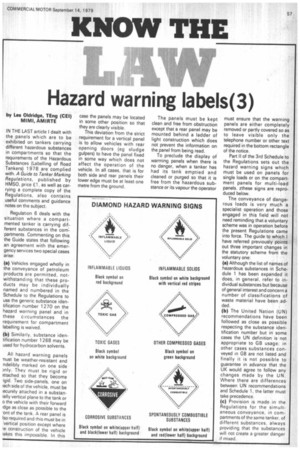Hazard warning labels(3)
Page 59

If you've noticed an error in this article please click here to report it so we can fix it.
by Les Oldridge, TEng (CEI) MIMI, AMIRTE
IN THE LAST article I dealt with the panels which are to be exhibited on tankers carrying different hazardous substances in compartments so that the requirements of the Hazardous Substances (Labelling of Road Tankers) 1 978 are complied with. A Guide to Tanker Marking Regulations, published by HMSO, price £1, as well as carrying a complete copy of the Regulations, also contains useful comments and guidance notes on the subject.
Regulation 6 deals with the situation where a compartmented tanker is carrying different substances in the compartments. Commenting on this the Guide states that following an agreement with the emergency services two special cases arise:
(a) Vehicles engaged wholly in the conveyance of petroleum products are permitted, notwithstanding that these products may be individually named and numbered in the Schedule to the Regulations to use the generic substance identification number 1 270 on the hazard warning panel and in these circumstances the requirement for compartment labelling is waived.
(b) Similarly, substance identification number 1 268 may be used for hydrocarbon solvents.
All hazard warning panels -nust be weather-resistant and ndelibly marked on one side )nly. They must be rigid or mached so that they become igid. Two side-panels, one on ach side of the vehicle, must be ecurely attached in a substanially vertical plane to the tank or o the vehicle with their forward ,dige as close as possible to the -ont of the tank. A rear panel is 'so required and this must be in vertical position except where le construction of the vehicle rakes this impossible. In this
case the panels may be located in some other position so that they are clearly visible.
This deviation from the strict requirement for a vertical panel is to allow vehicles with rear opening doors (eg sludge guiders) to have the panel fixed in some way which does not affect the operation of the vehicle. In all cases, that is for both side and rear panels their lower edge must be at least one metre from the ground. The panels must be kept clean and free from obstruction except that a rear panel may be mounted behind a ladder of light construction which does not prevent the information on the panel from being read.
To preclude the display of warming panels when there is no danger, when a tanker has had its tank emptied and cleaned or purged so that it is free from the hazardous substance or its vapour the operator must ensure that the warning panels are either completely removed or partly covered so as to leave visible only the telephone number or other text required in the bottom rectangle of the notice.
Part II of the 3rd Schedule to the Regulations sets out the hazard warning signs which must be used on panels for single loads or on the compartment panels for multi-load panels. zthese signs are reproduced below.
The conveyance of dangerous loads is very much a specialist operation and those engaged in this field will not need reminding that a voluntary scheme was in operation before the present Regulations came into force. The guide to which I have referred previously points out three important changes in the statutory scheme from the voluntary one: (a) Although the list of names of hazardous substances in Schedule 1 has been expanded it does, in general, refer to individual substances but because of general interest and concern a number of classifications of waste material have been added.
(b) The United Nation (UN) recommendations have been followed as close as possible respecting the substance identification number but in some cases the UN definition is not appropriate to GB usage; in other cases substances conveyed in GB are not listed and finally it is not possible to guarantee in advance that the UK would agree to follow any changes made by the UN. Where there are differences between UN recommendations and Schedule 1, the latter must take precedence.
(c) Provision is made in the Regulations for the simultaneous conveyance, in compartments of the same tanker, of different substances, always providing that the substances will not create a greater danger if mixed.




















































































































































